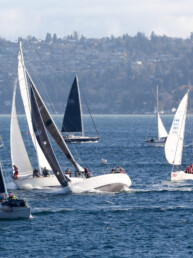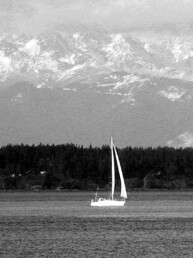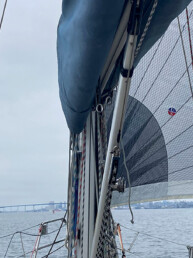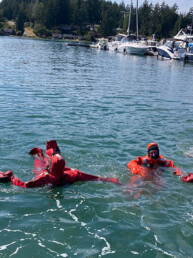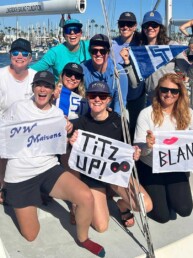In recent issues of 48° North, we’ve shared with readers how a unique partnership transpired that has enabled my husband Justin and I to purchase and campaign a SunFast 3300 in Europe with Jonathan McKee and his co-skipper Alyosha Strum-Palerm. Now, we’ll share a bit about how our first races unfolded as we jumped into racing the new boat, Red Ruby, out of the famous Solent.
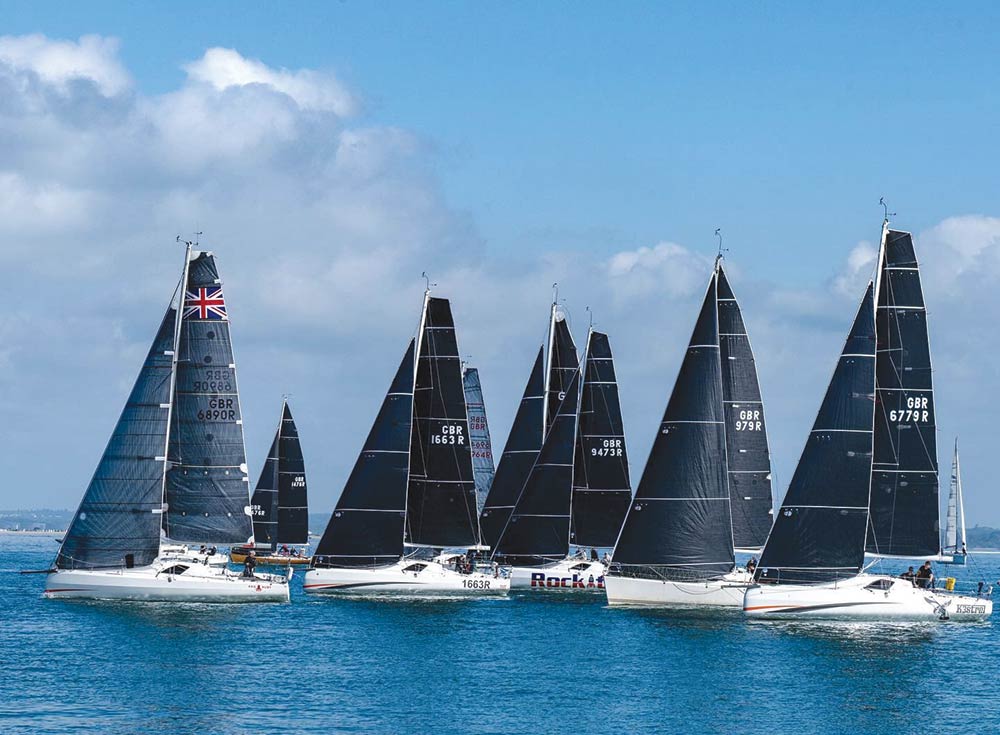
Justin and I had committed to racing in several of the UK Doublehanded (DH) Offshore Series events in order to qualify for ranking in the overall results for the series. The series required a minimum of four races to be scored in the overall, so we opted to race only four events — shoreside commitments and too few frequent flier miles kept us from doing more. Our races would be the De Guingand Bowl (115 miles), the Myth of Malham (230 miles), and two back-to-back UK DH National races in September.
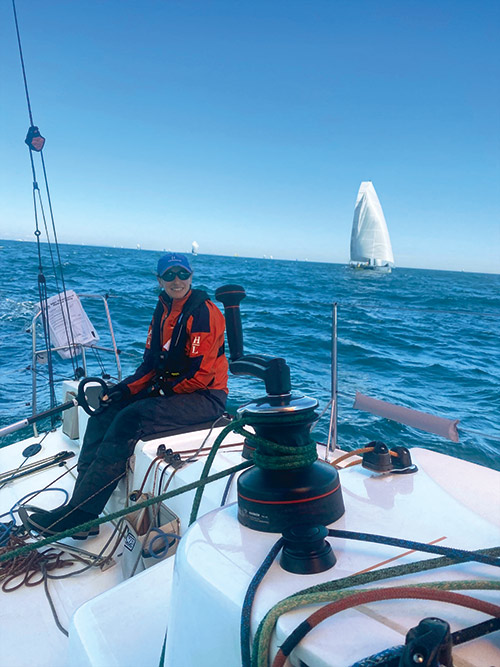 De Guingand Bowl
De Guingand Bowl
Our first race on Red Ruby, the De Guingand Bowl in May, was a fantastic experience. The start area was directly off of Cowes, on the Isle of Wight, and apparently in the path of the high speed catamaran ferries. In the starting sequence for the classes right ahead of ours, one of the ferries gave five horns to some of the racers. In the Pacific Northwest this might have been instant disqualification, but maybe it’s more civilized in the UK, “Excuse my quick ship, but I must hurry through. Cheers!” Right before our starting sequence, we had a very warm hello and welcome from RockIt, which is co-skippered by sailing icons Dee Caffari (who had raced the previous two seasons on Red Ruby, when the boat was called Gentoo) and Shirley Robinson. We had friendly waves from the others, too. We ended up with an excellent start, and even a picture to prove it (note: yes, the Americans do have a very large Union Jack on their mainsail).
The leg west in the Solent was a tactical one, trying to stay in phase with shifts and balancing current effects (deeper water in the middle meant more favorable current) with land breeze effects. The course had two lines of longitude as turnarounds, rather than marks — very tricky to optimize routing for that. We did well racing to the western line of longitude, where we jibed and then began our leg to the eastern line of longitude. We opted to stay inshore, close to the Isle of Wight, hoping for early benefits from the expected current switch, and we got them. We made huge gains inshore against the fleet who stayed more offshore to the south. We were then banking on an expected left shift that would have us on the inside of the lift.
At the western line of longitude we tacked and hoisted our A2 spinnaker for the run to the finish. After hoisting, the breeze was holding at 10-12 knots, a band in which we found it surprisingly difficult to drive the SunFast. In our light-air PNW sailing, these would have been perfect conditions for our very responsive J/111, but Red Ruby felt much less so — likely due to the twin rudders. Luckily, we didn’t have to wait too long before things changed, the breeze built to 15-20 knots as we approached the Solent. We liked that better and felt the boat was in a really nice groove!
We then had another surprise when a boat appeared, without AIS, and we realized it was the SunFast 3300 Atomic — suddenly we were in a very close boat-on-boat race to the finish. We had to jibe to stay in the channel, and we took Atomic’s stern. When we jibed back, we found ourselves reaching in a narrow channel right behind them. We had our staysail out and started working to windward of Atomic. We made our move, ready to remind them that under COLREGS, at night, they weren’t supposed to luff us up; but of course, they were completely polite and let us by without issue.
We got by and did our best to focus on boat speed. Justin reminded us that this was one SunFast 3300 we actually owed time — variations in design mean some SunFast 3300s have different ratings. After a few tense jibes and some intensely-focused nighttime navigation to the finish, we managed to get to the finish line one second before Atomic for line honors in IRC 2 and IRC DH. When the race committee confirmed the order of finish, we may have broken English decorum as we cheered very loudly into the night. Once the handicaps were applied, it turned out that we were second overall for the race, second in IRC Class 2, and second in the doublehanded class — all behind Atomic. We were really pleased, even a bit surprised since this was our first race on Red Ruby and first race in the UK. After months of preparation and wondering, this was a pleasant affirmation that we could be competitive overseas.
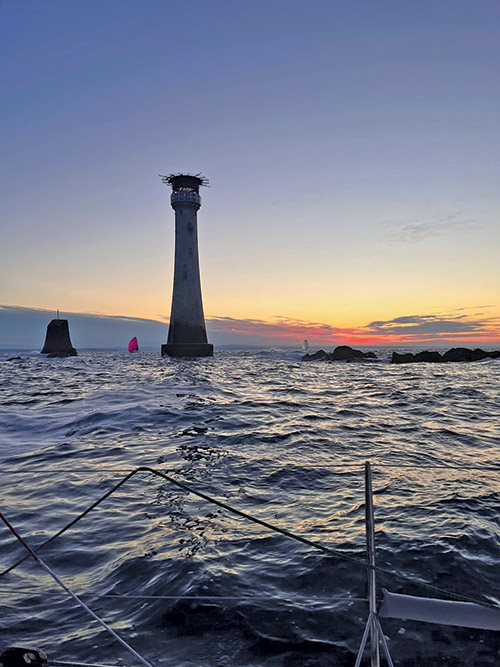 Myth of Malham
Myth of Malham
In June, our second race of the year on Red Ruby was the Myth of Malham — a 230 mile race that would provide a preview of the first 115 miles of the famous Fastnet course. We started in an uncharacteristic easterly that launched us downwind in favorable current out of the Solent. Similar to the de Guingand race, Justin and I got into our onboard routine after exiting the Solent (about 13 miles), where we started 30-minutes-on/30-minutes-off for the remainder of the race (outside of major navigation decisions and sail changes). Offwatch time allows us to eat, hydrate, navigate, and catch a 15-minute nap which provides a surprising amount of energy. We’ve found that starting to rest early, even for very brief periods, prevents fatigue and brain-fog from setting in later in the race.
We took down the kite at the Needles, a bit less gracefully than normal as the breeze went forward. We swapped to the Code Zero and genoa staysail quickly for a few miles, before resetting the A2 spinnaker again in a backing breeze that we held to the turnaround. We were the second SunFast 3300 around the Eddystone Light.
Our return leg was more challenging. We faced weather transitions and key routing decisions that ended up being pivotal for the race. After Eddystone, we were close-reaching back towards the Solent. Most of our fleet was opting for the rhumbline, which was the more northerly course, but we made the decision to foot for speed towards the header we expected when the northerly transitioned to an easterly. As a result, we ended up being the boat farthest south in our fleet. We chose to stay in touch with the fleet rather than take the right-hand turn the routing was calling for, but that positioning was enough to pay well. We reached the header first, tacked, and crossed all but one boat in our IRC 2 fleet.
In Lyme Bay, approximately 40 miles from the finish, the breeze shutdown but the current (unhelpfully) did not. We found ourselves struggling mightily. We had managed to crawl to within a quarter-mile of our class leader, Mzungu!, but then watched them sail away when they found a zephyr we couldn’t reach. We ended up sailing backwards in the current to get into pressure before we could escape. In that time, Mzungu! put 2 miles on us.
The breeze picked up again as we approached Duriston Head, the last major headland before the finish, and we short-tacked along that shore to take advantage of the current and breeze acceleration. We were on the homestretch to the finish, trying to go as fast as we could, in case we could correct out on Mzungu!, who owed us some time. We crossed the finish line at Hearst Castle right before 1 a.m., about 36 hours after we started. We wound up missing out on the top spot in IRC Doublehanded and IRC 2 by about 15 minutes (second again!). We were nonetheless quite pleased to have been able to keep all of the other 12 Sunfast 3300s at bay.
The trip home to the marina was definitely as epic as the race. The forecast easterly front rolled in with a change in tide (an unfavorable ebb, of course), so we had a 4-hour slog motorsailing back to our slip in eyeball-piercing rain, even having to dodge a cruise ship in the dark.
We’re definitely learning a lot, but also having an amazing time with this Red Ruby adventure. It’s telling when you are immediately talking about the next race despite being sleep-deprived and hungry and cold. From word go, it has been incredibly fun to be experiencing new waters, sailors, and boats, while representing the Pacific Northwest abroad.

